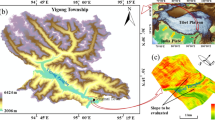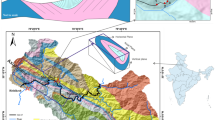Abstract
Rock fracture deformation of urban informatization in China’s modernization drive by DDARF (discontinuous deformation analysis for rock failure) software has been studied on in this paper. At first, the primitive DDARF software is developed and added into two improvements. Also, the program of DDARF’s model established by CAD and put into the DDARF software. Then, displacement convergence criterion of the DDARF is simulated. Finally, rock fracture deformation and stress rupture characteristics under the conditions of single axle stress are investigated. In a word, information processing on rock fracture deformation and its application in geo-technical engineering has been concerned.
Access this chapter
Tax calculation will be finalised at checkout
Purchases are for personal use only
Similar content being viewed by others
References
Shi, Gen-hua. 1988. Discontinuous deformation analysis—A new numerical model for the statics and dynamics of block system, 1–89. Berkeley: Department of Civil Engineering, University of California.
Chang, T.C. 1994. Nonlinear dynamic discontinuous deformation analysis with finite element meshed block systems, 25–78. Berkeley: University of California.
Qinghui, Jiang. 2000. Research on three dimensional discontinuous deformation analysis method, 1–33. Wuhan: Institute of Rock and Soil Mechanics, Chinese Academy of Sciences.
Cheng, Yungming, Yonghui Zhang, and Kejun Wang. 2000. Coupling of FEM and DDA method. Chinese Journal of Geotechnical Engineering 22 (6): 727–730.
Maclaughlin, M.M., N. Sitar, D.M. Doolin, et al. 2001. Investigation of slope stability kinematics using discontinuous deformation analysis. International Journal of Rock Mechanics and Mining Sciences 38 (6): 753–762.
Chen, S., J.C. Chern, and C.Y. Koo. 1995. Study on performance of tunnel near slope by DDA. In Proceedings of the first international conference on analysis of discontinuous deformation, ed. J.C. Li, C.Y. Wang, and J. Sheng, 109–123. Chungli, Taiwan ROC: National Central University.
Liu, L. 1996. Modeling aseismic fault slips and block deformation in northern China by DDA. In Proceedings of the first international forum on discontinuous deformation analysis (DDA) and simulations of discontinuous media, Berkeley, CA, ed. M.R. Salami and D. Banks, 373–382. Albuquerque, NM: TSI Press.
Kieffer, D.S. 1994. Surface displacement rate of a deep seated bedrock topple at Mexican Gulch, Calaveras County, California. Technical Report, University of California, Berkeley.
Kieffer, D.S. 1998. Rock slumping: A compound failure mode of jointed hard rock slopes. Ph.D. Thesis, University of California, Berkeley, California.
Hatzor, Y.H., and R. Benary. 1998. The stability of a laminated Voussoir beam: Back analysis of a historic roof collapse using DDA. International Journal of Rock Mechanics and Mining Science and Geomechanics Abstracts 35: 165–181.
Hatzor, Y.H. 1999. The Voussoir beam reaction curve. In ICADD-3: Third international conference on analysis of discontinuous deformation—From theory to practice, ed. B. Amadei, 117–126. Rotterdam and Washington, DC: American Rock Mechanics Association and Balkema.
Chang, C.S. 1994. Nonlinear dynamic discontinuous deformation analysis with finite element meshed block system. Ph.D. Thesis, University of California, Berkeley.
Koo, C.Y., J.C. Chern, and S. Chen. 1995. Development of second order displacement function for DDA. In Proceedings of the first international conference on analysis of discontinuous deformation, ed. J.C. Li, C.Y., Wang, and J. Sheng, 91–108. Chungli, Taiwan ROC: National Central University.
Koo, C.Y., and J.C. Chern. 1996. The development of DDA with third-order displacement function. In Proceedings of the first international forum on discontinuous deformation analysis (DDA) and simulations of discontinuous media, Berkeley, CA, ed. M.R. Salami and D. Banks, 342–349. Albuquerque, NM: TSI Press.
Ma, M.Y., M. Zaman, and J.H. Zhou. 1996. Discontinuous deformation analysis using the third-order displacement function. In Proceedings of the first international forum on discontinuous deformation analysis (DDA) and simulations of discontinuous media, Berkeley, CA, ed. M.R. Salami and D. Banks, 383–394. Albuquerque, NM: TSI Press.
Lin, Shao-zhong. 1997. Improved iterative format of symmetric successive over relaxation-preconditioned conjugated gradient mthod. Journal of Numerical Methods and Computer Applications 4: 266–270.
Lin, Shao-zhong. 1998. Application of preconditioned conjugated gradient method to finite element equations and program design. Journal of Hehai University 26 (3): 112–115.
Bai, Jianbiao, Xiangyu Wang, Mingkui Jia, et al. 2008. Theory and application of supporting in deep soft roadways. Chinese Journal of Geotechnical Engineering 30 (5): 632–635.
Clatworthy, D., and F. Scheele. 1999. A method of sub-meshing in discontinuous deformation analysis (DDA). In ICADD-3: Third international conference on analysis of discontinuous deformation—From, theory to practice, ed. B. Amadei, 85–96. Rotterdam and Washington, DC: American Rock Mechanics Association and Balkema.
Koo, C.Y., and J.C. Chern. 1997. Modeling of progressive fracture in jointed rock by DDA method. In Proceedings of the second international conference on analysis of discontinuous deformation, ed. Y. Ohnishi, 186–201. Kyoto, Japan: Japan Institute of Systems Research.
Jiang Qinghui, and Chuangbing Zhou. 2007. Some issues in discontinuous deformation analysis for geotechnical engineering. Chinese Journal of Rock Mechanics Engineering 26 (10): 2014–2026.
Zhang, Xiuli, Yuyong Jiao, and Quansheng Liu. 2008. On modeling of pre-tension bolt in discontinuous deformation analysis method. Chinese Journal of Underground Space and Engineering 4 (1): 38–41.
Zheng, Chunmei. Study on hydro-mechanical coupling of fractured rock mass based on DDA, 55–94. Jinan: Shandong University.
Jiao, Yuyong, Xiuli Zhang, Quansheng Liu, et al. 2007. Simulation of rock crack propagation using discontinuous deformation analysis. Chinese Journal of Rock Mechanics and Engineering 26 (4): 682–691.
Zhang, Xiuli. Study on numerical methods for modeling failure process of semicontinuous jointed rock mass, 29–68. Wuhan: Institute of Rock and Soil Mechanics, Chinese Academy of Sciences.
Zhang, Xiuli, Yuyong Jiao, Quansheng Liu, et al. 2007. Modeling of stability of a highway tunnel by using improved DDA method. Rock and Soil Mechanics 28 (8): 1710–1714.
Kim, Y.I., B. Amadei, and E. Pan. 1999. Modeling the effect of geology on uplift in concrete gravity dam foundations. In Rock mechanics for industry proceedings of the 37th U.S. rock mechanics symposium, ed. B. Amadei, R.L. Kranz, G.A. Scott, and P.H. Smeallie, 527–534.
Grenoble, B.A. 1989. Influence of geology on seepage and uplift in concrete gravity dam foundations. Ph.D. Thesis, University of Colorado, Boulder.
Sneddon, I.N., and M. Lowengrub. 1969. Crack problems in the classical theory of elasticity. New York: Wiley.
Yamamoto, T., H.L. Konig, H. Sellmejjer, and E.V. Hijum. 1978. On the response of a poro-elastic bed to water waves. Journal of Fluid Mechanics 87: 193–206.
Yeung, M.R., and S.C. Blair. 1999. Analysis of large block test data using DDA method. In ICADD-3: third international conference on analysis of discontinuous deformation—From theory to practice, 141–150, ed. B. Amadei. Rotterdam and Washington, DC: American Rock Mechanics Association and Balkema.
Hsiung, S.M. 2001. Discontinuous deformation analysis (DDA) with nth order polynomial displacement functions. In Rock mechanics in the national interest, proceedings of the 38th U.S. rock mechanics symposium, ed. D. Elsworth, J.P. Tinucci, and K.A. Heasley, 1437–1444. Rotterdam and Washington, DC: American Rock Mechanics Association and Balkema.
Liu, Jun. 2001. Three dimensional discontinuous deformation analysis coupled with finite element method, 80–105. Dalian: Dalian University of Technology.
Wu, Aiqing, Xiuli Ding, Shenghong Chen, et al. 2006. Researches on deformation and failure characteristics of an underground powerhouse with complicated geological conditions by DDA method. Chinese Journal of Rock Mechanics and Engineering 25 (1): 1–8.
Yongzheng, M.A., Hong Zheng, and Chunguang Li. 2008. Applying natural neighbor—Interpolation to discontinuous deformation analysis of block system. Rock and Soil Mechanics 29 (1): 119–124.
Author information
Authors and Affiliations
Corresponding author
Editor information
Editors and Affiliations
Rights and permissions
Copyright information
© 2020 Springer Nature Singapore Pte Ltd.
About this paper
Cite this paper
Wang, W., Han, R., Zhu, Y., Wu, M. (2020). Analysis of Rock Fracture Deformation of Urban Informatization in China’s Modernization Drive by DDARF Software. In: Huang, C., Chan, YW., Yen, N. (eds) Data Processing Techniques and Applications for Cyber-Physical Systems (DPTA 2019). Advances in Intelligent Systems and Computing, vol 1088. Springer, Singapore. https://doi.org/10.1007/978-981-15-1468-5_88
Download citation
DOI: https://doi.org/10.1007/978-981-15-1468-5_88
Published:
Publisher Name: Springer, Singapore
Print ISBN: 978-981-15-1467-8
Online ISBN: 978-981-15-1468-5
eBook Packages: Intelligent Technologies and RoboticsIntelligent Technologies and Robotics (R0)




